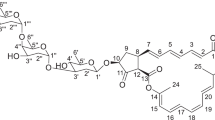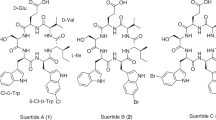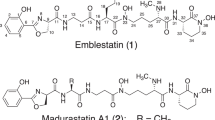Abstract
NW-G01, a novel cyclic hexadepsipeptide antibiotic, was isolated by macroporous resin and silica gel column chromatography and HPLC from the fermentation broth of strain no. 313. The producing strain was identified as Streptomyces alboflavus on the basis of the morphological characteristics, physiological property and 16S rDNA gene sequence analysis. NW-G01 exhibited strong antibacterial activity against Bacillus subtilis, Bacillus cereus, Staphylococcus aureus, methicillin-resistant S. aureus, and their MIC values were 3.90, 3.90, 7.81 and 7.81 μg ml−1, respectively.
Similar content being viewed by others
Introduction
In the course of a screening program for new antibiotics from microbial products, an actinomycete strain no. 313, isolated from a soil sample collected from the Shaanxi province of China, was found to produce a novel cyclic hexadepsipeptide antibiotic, designated as NW-G01. The chemical structure of NW-G01 incorporates valine, N-methylalanine, a chlorinated pyrroloindoline derivative, and three molecules of piperazic acid (Figure 1). NW-G01 is structurally related to himastatin1 and chloptosin,2 two cyclic hexadepsipeptide antitumor antibiotics, but is significantly different in the amino acid content. Another important difference between them is that the two reported antibiotics are the dimers of cyclohexapeptide. Taxonomic studies showed that the producing strain belongs to the species of Streptomyces alboflavus. The bioassay results showed that NW-G01 had strong antibacterial activity against gram-positive bacteria, including methicillin-resistant Staphylococcus aureus (MRSA), but was ineffective against gram-negative bacteria.
In this paper, we described the taxonomy of the producing organism, fermentation, isolation, physicochemical properties and antibacterial activities. The structural elucidation of NW-G01 will be reported in the following paper.
Results
Taxonomy of the producing strain
Strain no. 313 grew well on most of the media and produced no distinctive soluble pigment. It formed well-developed and branching substrate mycelium, but rare aerial mycelium, and typical a spore chain was observed on the International Streptomyces Project (ISP) media. The mature spore chain was straight or slightly curved and broken easily on modified humic acid–vitamins (HV) agar; the spores were cylindrical to oval shape, in sizes of 0.5–2 μm, with a smooth surface observed through the scanning electron photo microscope (Figure 2).
Good growth could be observed on modified HV agar, Czapek's agar, glucose asparagine agar, ISP2, ISP3, ISP5 and ISP6, but no growth was observed on ISP4. The best medium for the culture of this strain was modified HV agar, on which it grew well. The culture characteristics of the strain are described in detail in Table 1.
Special morphology, such as sclerotia or sporangia, was not observed. Carbon utilization and physiological characteristics of strain no. 313 were summarized in Table 2. The results of diaminopimelic acid (DAP) analysis showed the presence of L-DAP in the peptidoglycan, indicating that strain no. 313 belonged to cell wall type I.3 Glucose and ribose were detected in the whole-cell hydrolysates. Strain no. 313 utilized D-dextrose, D-maltose, inositol, D-mannitol, L-rhamnose, D-xylose, L-arabinose, D-fructose and D-mannose as sole carbon sources, but not sucrose, D-ribose, lactose and D-galactose. Gelatin liquefaction, coagulation and peptonization of the milk test showed positive results at 7 days. Hydrolysis of starch was not observed before 14 days. The above results support the identification of this strain as a member of the genus Streptomyces. Furthermore, 16S rDNA sequence (1471 nucleotides) of strain no. 313 was determined and registered in the GenBank (FJ032029). The phylogenetic analysis with 16S rDNA database sequences revealed that strain no. 313 branched deeply within a member of the gene Streptomyces and was most closely related to S. alboflavus NBRC-13196T4 (Figure 3). As the sequence similarity was high (99.5%) and most morphological and physiological characteristics were highly similar, except for the coagulation of milk, strain no. 313 might be identified as S. alboflavus 313.
Cultivation and fermentation
Strain no. 313 was cultivated at 28 °C in the modified HV medium, which contained soluble starch 1%, KCl 0.17%, FeSO4 7H2O 0.001%, VB1 0.00005%, VB3 0.00005%, para-aminobenzoic acid 0.00005%, Na2HPO4 0.05%, cycloheximide 0.005%, MgSO4 7H2O 0.05%, CaCO3 0.002%, VB2 0.00005%, VB6 0.00005%, myoinositol 0.00005%, biotin 0.000025%, KNO3 0.3% and agar 1.8%, at pH 7.2 adjusted with NaOH. The seed medium consisted of millet extract 1%, glucose 1%, peptone 0.3%, NaCl 0.25% and CaCO3 0.1% (pH 7.0). A 500-ml Erlenmeyer flask, containing 150 ml of the seed medium, was incubated with a stock culture of the producing strain maintained on a modified HV agar slant. After incubation for 24 h at 28 °C on a rotary shaker set at 180 r.p.m., 5 ml of the seed culture was transferred to each of the 250 ml Erlenmeyer flasks containing 65 ml of the production medium, which consisted of millet extract 1%, glucose 1%, peptone 0.3%, NaCl 0.25% and CaCO3 0.2% (pH 7.0). The fermentation was carried out at 28 °C for 5 days on a rotary shaker set at 180 r.p.m.
Extraction and isolation
The culture of 100 l was filtered with a cheesecloth to separate the medium and culture liquid. The culture liquid, which exhibited strong antibacterial activity, was absorbed onto a macroporous resin (HPD400, Cangzhou Baoen, Co. Ltd, Cang Zhou City, China), followed by elution with methanol. The methanol fractions were evaporated at 40 °C in vacuum to yield 60 g of extract. The extract was subjected to a silica gel column (600 g, 200–300 mesh, 6.5 × 110 cm) and eluted with petroleum ether, EtOAC–MeOH (100:0, 75:25, 50:50, 25:75, 0:100, v/v). The eluents were collected at 2000 ml for each fraction. The antimicrobial fraction was purified by reverse phase-HPLC (Hypersil C18, 20 × 250 mm, 10 μm) with methanol/water (75:25, v/v) as mobile phase to yield compound NW-G01 (1.60 g).
Physicochemical properties
Physicochemical properties of NW-G01 are summarized in Table 3. The compound was soluble in methanol, ethyl acetate and dimethyl sulfoxide, but was insoluble in water and acetone. The compound displayed a positive reaction to iodine vapor and AgNO3 solution. The spectra of HR-ESI-MS (m/z 757.3460[M+H]+) showed that the molecular weight of NW-G01 was 756 (Figure 4).
Antibacterial activities
The compound NW-G01 exhibited significant activity against several gram-positive bacteria (Table 4) with MIC values of less than 10 μg ml−1. No obvious inhibitory effects were observed against gram-negative at the concentration of 250 μg ml−1. The tested gram-positive bacteria were Bacillus cereus 1.1846, Bacillus subtilis 1.88, S. aureus 1.89, MRSA 212 and the gram-negative were Escherichia coil 1.1636, Pseudomonas aeruginosa 1.2031 and Erwinia carotovora.
Discussion
In this paper, we presented a novel antibacterial cyclic hexadepsipeptide, NW-G01, isolated from the fermentation broth of strain no. 313. The results of the studies on morphological and physiological characteristics indicated that strain no. 313 had a high concordance with S. alboflavus NBRC-13196T, and the high similarity (99.5%) with 16S rDNA sequence, despite the obvious difference, was that the milk was coagulated for the strain no. 313. Therefore, strain no. 313 was named as S. alboflavus 313. The structure of NW-G01 is related to himastatin and chloptosin, which are dimers of cyclic hexadepsipeptide.
In this study, the antibacterial activities of NW-G01 against seven species of representative bacteria were tested. NW-G01 exhibited higher antibacterial activities than did ampicillin against four species of gram-positive bacteria, especially against MRSA, the MIC value of NW-G01 was 7.81 μg ml−1 and that of ampicillin was more than 100 μg ml−1 (Table 4). It was reported that chloptosin2 and himastatin,1, 5 the two similar cyclopeptides with NW-G01, had antitumor activity. The antitumor activity of NW-G01 will be evaluated subsequently. The above results suggest that NW-G01 may be a potential candidate as a pharmaceutical product.
Methods
Isolation of the producing strain
The producing strain no. 313 was isolated from a soil sample collected from the Shaanxi province of China. Soil sample 1.0 g, combined with CaCO3 (0.1 g), was incubated for 1 h at 110°C and suspended in 20 ml sterile water. After filtration and dilution with sterile water (10−1, 10−2, 10−3 and 10−4) containing 1.5% phenol, 0.1 ml aliquots were spread onto modified HV agar and modified Bennett's agar6 containing 1 μg potassium dichromate. The plates were incubated for 14 days at 28 °C, and the resulting colonies were transferred and maintained on the modified HV agar. Among the isolated strains, one strain that showed significant antibacterial activity was designated as strain no. 313.
Taxonomy of the producing strain
The studies on cultural and physiological characteristics of the producing strain were carried out following the methods recommended by the ISP7 and Waksman,8 and the utilization of carbon sources was tested according to the growth condition on plates containing different sugar sources. The morphological properties were observed with a scanning electron microscope (JSM6360LV JEOL). The isomers of DAP and whole-cell sugar pattern were determined by TLC analysis of the whole-organism hydrolysate.9 Extraction of genomic DNA and 16S rRNA gene amplification were carried out according to Kim et al.10 The 16S rDNA sequence was aligned using CLUSTAL X software version 1.83. A phylogenetic tree was constructed by the neighbor-joining method11 using MEGA version 4.0 software, and Bootstrap analyses of 1000 replicates were carried out.
Assay for antibacterial activity
Antibacterial activity was measured by the micro-broth dilution method in 96-well culture plates using the Mueller-Hinton (MH) broth (Hangzhou Microbial Reagent Co. Ltd, Hangzhou City, China), according to the Standard of National Committee for Clinical Laboratory.12 The standard bacterial strains were obtained from the China General Microbiological Culture Collection center. A clinical isolate of MRSA was obtained from Nanjing Medical University. Ampicillin (Sigma, Shanghai, China) was used as positive control. The tested bacteria were incubated in the MH broth for 12 h at 30 °C at 190 r.p.m., and the spore concentration was diluted to approximately 1 × 105–1 × 106 CFU with MH broth. After incubation for 24 h at 30 °C, the MICs were examined.
General procedure
Melting point was measured on an X-4 apparatus and was uncorrected. Optical rotation was measured on a Perkin-Elmer 341 polarimeter. IR spectra were determined on an IR-450 instrument (KBr plate). HR-ESI-MS was obtained on a Brüker Apex II mass spectrometer. Mass spectra were measured on a Finnigan LCQ Advantage mass spectrometer (ESI, positive mode). The compound was purified by a Shimadzu 6AD HPLC apparatus with preparation column Hypersil C18 (20 × 250 mm, 10 μm). Silica gel (200–300 mesh, Qingdao Haiyang Chemical Co. Ltd, Qingdao City, China) and HPD-400 macroporous resin (Cangzhou Baoen, Co. Ltd) were used for column chromatography.
References
John, E. L. et al. Himastatin, a new antitumor antibiotic from Streptomyces hygroscopicus III. Structural elucidation. J. Antibiot. 49, 299–311 (1996).
Umezawa, K., Ikeda, Y., Uchihata, Y., Naganawa, H. & Kondo, S. Chloptosin, an apoptosis-inducing dimeric cyclohexapeptide produced by Streptomyces. J. Org. Chem. 65, 459–463 (2000).
Lechevalier, M. P. & Lechevalier, H. A. chemical composition as a criterion in the classification of aerobic actinomycetes. Int. J. Syst. Bacteriol. 20, 435–443 (1970).
Shirling, E. B. & Gottlieb, D. Cooperative description of type cultures of Streptomyces. III. Additional species descriptions from first and second studies. Int. J. Syst. Bacteriol. 18, 288–289 (1968).
Leet, J. E., Schroeder, D. R., Krishnan, B. S. & Matson, J. A. Himastatin, a new antitumor antibiotic from Streptomyces hygroscopicus. I. Taxonomy of the producing organism, fermentation and biological activity. J. Antibiot. 43, 956–960 (1990).
Atlas, R. M. Handbook of Microbiological Media, 3rd edn, 206 (CRC Press, Boca Raton, London, New York, Washington, DC, 2004).
Shirling, E. B. & Gottlieb, D. Methods for characterization of Streptomyces species. Int. J. Syst. Bacteriol. 16, 313–340 (1966).
Waksman, S. A. & Henrici, A. T. The nomenclature and classification of the actinomycetes. J. Bacteriol. 46, 337–341 (1943).
Becker, B., Lechvalier, M. P. & Lechvalier, H. A. Chemical composition of cell-wall preparation from strains of various form-genera of aerobic actinomycetes. Appl. Microbiol. 13, 236–243 (1965).
Kim, S. B. & Goodfellow, M. Streptomyces thermospinisporus sp. nov., a moderately thermophilic carboxydotrophic streptomycete isolated from soil. Int J. Syst. Evol. Microbiol. 52, 1225–1228 (2002).
Saitou, N. & Nei, M. The neighbor-joining method: a new method for reconstructing phylogenetic trees. Mol. Biol. Evol. 4, 406–425 (1987).
Clinical and Laboratory Standards Institute. Methods for dilution antimicrobial susceptibility tests for bacteria that grow aerobically. Approved standard M7-A7 (2006).
Acknowledgements
This study was supported in part by a grant from The National Key Basic Research Program (973 Program, 2003CB114404) from the Science and Technology Ministry of China.
Author information
Authors and Affiliations
Corresponding author
Rights and permissions
About this article
Cite this article
Guo, Z., Shen, L., Ji, Z. et al. NW-G01, a novel cyclic hexadepsipeptide antibiotic, produced by Streptomyces alboflavus 313: I. Taxonomy, fermentation, isolation, physicochemical properties and antibacterial activities. J Antibiot 62, 201–205 (2009). https://doi.org/10.1038/ja.2009.15
Received:
Accepted:
Published:
Issue Date:
DOI: https://doi.org/10.1038/ja.2009.15
Keywords
This article is cited by
-
Targeted isolation of antitubercular cycloheptapeptides and an unusual pyrroloindoline-containing new analog, asperpyrroindotide A, using LC–MS/MS-based molecular networking
Marine Life Science & Technology (2023)
-
Identification of pyrroloindoline-containing cyclic hexapeptides in the metabolites of Streptomyces alboflavus 313 by HPLC-DAD-ESI-MS/MS
The Journal of Antibiotics (2013)
-
Two piperazic acid-containing cyclic hexapeptides from Streptomyces alboflavus 313
Amino Acids (2012)
-
Cyclo(PRO-TYR) from an endophytic rhizobium isolated from Glycyrrhiza uralensis
Chemistry of Natural Compounds (2012)
-
NW-G03, a related cyclic hexapeptide compound of NW-G01, produced by Streptomyces alboflavus 313
The Journal of Antibiotics (2011)







